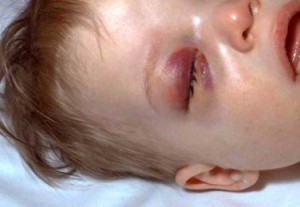Are you suffering from mild fever along with swollen eyelids or red eyes? If that is the case, you are probably suffering from Periorbital cellulitis. Read and know all about this pediatric ailment, including its symptoms, causes, complications, diagnosis, and treatment.
Periorbital cellulitis Definition
Page Contents
It is a bacterial infection of the eyelid that may also affect patches of skin surrounding the eye. It generally develops in a position anterior to the orbital septum, a fibrous sheet attached peripherally around the margin of the orbit or eye socket. In most cases, it is unilateral, affecting only one eye and does not spread to the other eye. It is sometimes denoted as “Preseptal cellulitis” that may progress into Orbital cellulitis, which is a serious form of infection of the eye tissues situated at a position posterior to the orbital septum.
Periorbital cellulitis Symptoms
Symptoms of this ailment are typically localized to the region close to the eyes. Systemic symptoms generally appear on other parts of the body.
Picture 1 – Periorbital cellulitis
Fever
In most cases, patients are observed to have a moderate elevation of body temperature that is often interspersed with chills.
Tenderness
Patients experience extreme discomfort and exhibit hypersensitivity to any form of touch or pressure on and around the eyelid.
Erythema
Erythematous eyelids, along with accumulation of debris along the eyelid margin, are one of the most common symptoms of this localized infection. In this condition, the lower and upper eyelids are prone to extreme redness.
Pain
It is usually mild but may turn severe depending on the degree of infection, causing extreme discomfort in the eye.
Chemosis
The opaque, outer white of the eye may undergo swelling, which may be a sign of ocular irritation. The areas surrounding the eye swells so much that patients find it very difficult to close their eyes completely.
Swelling
Patients occasionally have “puffy eyes” caused by swelling of the eyelids, and areas surrounding it.
Conjunctival injection
The outermost layer of the eye, known as “Conjunctiva”, undergoes acute inflammation and suffers from redness owing to bacterial infection.
Local heat
The swollen regions around the eye are often warm to touch, due to increased blood flow at body temperature to the site of inflammation.
Blurred vision
Patients may develop haziness in eye and may even experience difficulties in visualizing nearby objects.
Shut eye
In this condition, the movement of the eye gets affected. The eye tends to bulge. Sometimes, however, it may also swell and shut.
Discharge
This particular condition occurs when there is excess fluid in the eye which may cause itchiness and is seen in the form of pus.
Hardness
Swelling of the eye and eyelids frequently results in stiffness and acute discomfort.
Teary eyes
Bacterial infections frequently trigger the release of large amount of tears in order to lubricate the eyes. Due to this, patients may suffer from watery eyes.
Periorbital cellulitis Causes
Some of the primary causes of this disorder include:
Local skin abrasions
Breaks in the skin region around the eye may facilitate the entry of bacteria that may even spread to eyelid, thus accelerating the growth of infection. The route of transmission of such infections is mainly through the bloodstream. In later stages, the infection may spread to other parts of the body.
Sinusitis
Inflammation of the paranasal sinuses, surrounding the nasal cavity, generally occurs in response to upper respiratory tract infection that may even spread to the eyes. Micro-organisms causing such infections include Staphylococcus epidermidis, Staphylococcus aureus and Streptococcus bacteria.
Bacterial infection
Most common pathogenic organisms, like Staphylococcus and Streptococcus bacteria, are considered to be the main causative factors for this infection. These bacteria can easily find way into the eyes via eyelids by a mere scratch. Initially, Haemophilus or Bacillus influenza was the most common cause of this disorder. With the advent of Haemophilus influenza type B (Hib) vaccine, the risk of getting an infection from these influenza strains has been greatly reduced.
Spider or Insect bite
The condition may also arise from insect stings on eyes, which can cause immediate skin reaction like swelling and rash. Stings from bees, wasps, and hornets are usually painful. Bites from fire ants, mosquitoes, fleas, and mites are more likely to cause itching and puffiness. Spider bite can also cause redness and swelling, often accompanied by a sharp pain.
Tooth and mouth infections
Poor oral hygiene can contribute to infections such as Caries or Gingivitis that are usually not diagnosed and treated by physicians. Infections of the teeth and gum often spread to adjacent organs including eyes.
Eye makeup
Sleeping overnight with make-up over the eyes may also lead to an infection. Minute traces of make-up, left for days on the eyelid without being removed, can also cause this problem. If traces start accumulating, there can be serious consequences.
Stye/chalazion
It is a lump in or along the edge of an eyelid that often turns red and is generally caused by an infected eyelash follicle. A stye that occurs inside or under the eyelid is popularly known as hordeolum and may develop into a severe infection.
Periorbital cellulitis in children
This specific type of Cellulitis occurs more commonly in children and requires close monitoring. Studies have revealed that nearly 80% of patients suffering from this disorder are below the age of 10 years. Infants are also prone to this infection, the average age being 21 months.
Periorbital cellulites Complications
This common infection of the eyelid is found to be associated with a number of serious complications like:
- Cavernous sinus thrombosis
- Encephalitis
- Vision loss
- Meningitis
- Orbital cellulitis
- Osteomyelitis
Periorbital cellulitis Diagnosis
Proper diagnosis and management of this condition is very essential and should be done at the onset of symptoms. In the initial stage of diagnosis, patients are generally asked about their medical history in order to determine the origin of the infection. This is generally followed by some laboratory and diagnostic tests as recommended by physicians.
Picture 2 – Periorbital cellulitis Image
Physical exam
This is usually done to check any sort of abnormality at the affected region that may include conjunctivitis, swelling, redness, or an insect bite.
Blood test
Complete blood count is a common blood test that measures the concentration of the cellular components of the blood such as red blood cells, white blood cells and platelets. In case of any bacterial infection, there is an elevation of the white blood cell count which may aid in the diagnosis of this disorder.
Drainage culture
Discharge from the eye is often sent for culturing, to determine the presence of any bacteria. These swabs are necessary, especially if symptoms suggest Conjunctivitis.
X-ray
Accumulation of fluid around the eyes, as well in the sinuses, can easily be detected using this diagnostic technique.
Imaging studies
CT scanning is often the first imaging technique used, owing to its availability at most medical institutions. Here, Periorbital cellulitis may appear as an area of increased density, with swelling of the anterior orbital tissues and accumulation of orbital fat. MRI, on the other, hand is useful for the detection of early inflammatory changes within the orbit.
Periorbital cellulitis Treatment
If this condition is not treated properly, development of orbital abscess may occur. The vision of patients may get seriously threatened and can even lead to Meningitis. Factors such as age of patients, medical history, overall health and degree of infection usually help in deciding the appropriate treatment option which can be any of the following:
Oral antibiotic therapy
It is the only form of treatment available that aids in the eradication of bacteria. In older children or adults with mild infection, Co-amoxiclav, Cephalosporin or Ceftriaxone is administered extensively.
Intravenous antibiotics
These are usually preferred in case patients are not able to respond to the former technique, or if the condition turns severe. Type IV antibiotics consisting of cefuroxime and ceftriaxone are commonly prescribed by physicians. Other primary antibiotics include penicillin that should not be given to patients who are allergic to this drug.
Analgesics and Anti-inflammatory drugs
Acetaminophen is often administered to children for abatement of fever. Anti-inflammatory drugs such as ibuprofen are also given in order to reduce inflammation and discomfort in the eye.
Periorbital cellulitis is a serious but not contagious infection as it occurs underneath the outer layer of the skin and is curable. However, the bacteria causing this infection may spread from person to person and can often cause other forms of infections within the body. Due to this reason, patients must immediate seek medical attention in case of any serious wound or insect bite.
References:
http://en.wikipedia.org/wiki/Periorbital_cellulitis
http://www.patient.co.uk/doctor/Orbital-Cellulitis.htm
http://www.cellutitis.org/periorbitalcellutitis.html
http://www.babycenter.com/0_periorbital-cellulitis_1201479.bc


